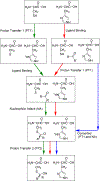Exploring the Mechanism of Covalent Inhibition: Simulating the Binding Free Energy of α-Ketoamide Inhibitors of the Main Protease of SARS-CoV-2
- PMID: 33205654
- PMCID: PMC7688048
- DOI: 10.1021/acs.biochem.0c00782
Exploring the Mechanism of Covalent Inhibition: Simulating the Binding Free Energy of α-Ketoamide Inhibitors of the Main Protease of SARS-CoV-2
Abstract
The development of reliable ways of predicting the binding free energies of covalent inhibitors is a challenge for computer-aided drug design. Such development is important, for example, in the fight against the SARS-CoV-2 virus, in which covalent inhibitors can provide a promising tool for blocking Mpro, the main protease of the virus. This work develops a reliable and practical protocol for evaluating the binding free energy of covalent inhibitors. Our protocol presents a major advance over other approaches that do not consider the chemical contribution of the binding free energy. Our strategy combines the empirical valence bond method for evaluating the reaction energy profile and the PDLD/S-LRA/β method for evaluating the noncovalent part of the binding process. This protocol has been used in the calculations of the binding free energy of an α-ketoamide inhibitor of Mpro. Encouragingly, our approach reproduces the observed binding free energy. Our study of covalent inhibitors of cysteine proteases indicates that in the choice of an effective warhead it is crucial to focus on the exothermicity of the point on the free energy surface of a peptide cleavage that connects the acylation and deacylation steps. Overall, we believe that our approach should provide a powerful and effective method for in silico design of covalent drugs.
Figures




Similar articles
-
Fast and Effective Prediction of the Absolute Binding Free Energies of Covalent Inhibitors of SARS-CoV-2 Main Protease and 20S Proteasome.J Am Chem Soc. 2022 May 4;144(17):7568-7572. doi: 10.1021/jacs.2c00853. Epub 2022 Apr 18. J Am Chem Soc. 2022. PMID: 35436404 Free PMC article.
-
Covalent and non-covalent binding free energy calculations for peptidomimetic inhibitors of SARS-CoV-2 main protease.Phys Chem Chem Phys. 2021 Mar 21;23(11):6746-6757. doi: 10.1039/d1cp00266j. Epub 2021 Mar 12. Phys Chem Chem Phys. 2021. PMID: 33711090
-
An insight into the interaction between α-ketoamide- based inhibitor and coronavirus main protease: A detailed in silico study.Biophys Chem. 2021 Feb;269:106510. doi: 10.1016/j.bpc.2020.106510. Epub 2020 Nov 28. Biophys Chem. 2021. PMID: 33285430 Free PMC article.
-
Docking Paradigm in Drug Design.Curr Top Med Chem. 2021;21(6):507-546. doi: 10.2174/1568026620666201207095626. Curr Top Med Chem. 2021. PMID: 33292135 Review.
-
Targeting SARS-CoV-2 Main Protease for Treatment of COVID-19: Covalent Inhibitors Structure-Activity Relationship Insights and Evolution Perspectives.J Med Chem. 2022 Oct 13;65(19):12500-12534. doi: 10.1021/acs.jmedchem.2c01005. Epub 2022 Sep 28. J Med Chem. 2022. PMID: 36169610 Free PMC article. Review.
Cited by
-
Fast and Effective Prediction of the Absolute Binding Free Energies of Covalent Inhibitors of SARS-CoV-2 Main Protease and 20S Proteasome.J Am Chem Soc. 2022 May 4;144(17):7568-7572. doi: 10.1021/jacs.2c00853. Epub 2022 Apr 18. J Am Chem Soc. 2022. PMID: 35436404 Free PMC article.
-
Haste makes waste: A critical review of docking-based virtual screening in drug repurposing for SARS-CoV-2 main protease (M-pro) inhibition.Med Res Rev. 2022 Mar;42(2):744-769. doi: 10.1002/med.21862. Epub 2021 Oct 26. Med Res Rev. 2022. PMID: 34697818 Free PMC article. Review.
-
Tuning Proton Transfer Thermodynamics in SARS-CoV-2 Main Protease: Implications for Catalysis and Inhibitor Design.J Phys Chem Lett. 2021 May 6;12(17):4195-4202. doi: 10.1021/acs.jpclett.1c00425. Epub 2021 Apr 26. J Phys Chem Lett. 2021. PMID: 33900080 Free PMC article.
-
The catalytic mechanism of the mitochondrial methylenetetrahydrofolate dehydrogenase/cyclohydrolase (MTHFD2).PLoS Comput Biol. 2022 May 25;18(5):e1010140. doi: 10.1371/journal.pcbi.1010140. eCollection 2022 May. PLoS Comput Biol. 2022. PMID: 35613161 Free PMC article.
-
Scaffold Hopping of α-Rubromycin Enables Direct Access to FDA-Approved Cromoglicic Acid as a SARS-CoV-2 MPro Inhibitor.Pharmaceuticals (Basel). 2021 Jun 5;14(6):541. doi: 10.3390/ph14060541. Pharmaceuticals (Basel). 2021. PMID: 34198933 Free PMC article.
References
-
- Zhou P; Yang XL; Wang XG; Hu B; Zhang L; Zhang W; Si HR; Zhu Y; Li B; Huang CL; Chen HD; Chen J; Luo Y; Guo H; Jiang RD; Liu MQ; Chen Y; Shen XR; Wang X; Zheng XS; Zhao K; Chen QJ; Deng F; Liu LL; Yan B; Zhan FX; Wang YY; Xiao GF; Shi ZL, A pneumonia outbreak associated with a new coronavirus of probable bat origin. Nature 2020, 579 (7798), 270–273. - PMC - PubMed
-
- Gorbalenya AE; Baker SC; Baric RS; de Groot RJ; Drosten C; Gulyaeva AA; Haagmans BL; Lauber C; Leontovich AM; Neuman BW; Penzar D; Perlman S; Poon LLM; Samborskiy DV; Sidorov IA; Sola I; Ziebuhr J; Grp CS, The species Severe acute respiratory syndrome-related coronavirus: classifying 2019-nCoV and naming it SARS-CoV-2. Nat Microbiol 2020, 5 (4), 536–544. - PMC - PubMed
-
- Guy RK; DiPaola RS; Romanelli F; Dutch RE, Rapid repurposing of drugs for COVID-19. Science 2020, 368 (6493), 829–830. - PubMed
-
- Anand K; Ziebuhr J; Wadhwani P; Mesters JR; Hilgenfeld R, Coronavirus main proteinase (3CL(pro)) structure: Basis for design of anti-SARS drugs. Science 2003, 300 (5626), 1763–1767. - PubMed
MeSH terms
Substances
Grants and funding
LinkOut - more resources
Full Text Sources
Miscellaneous

